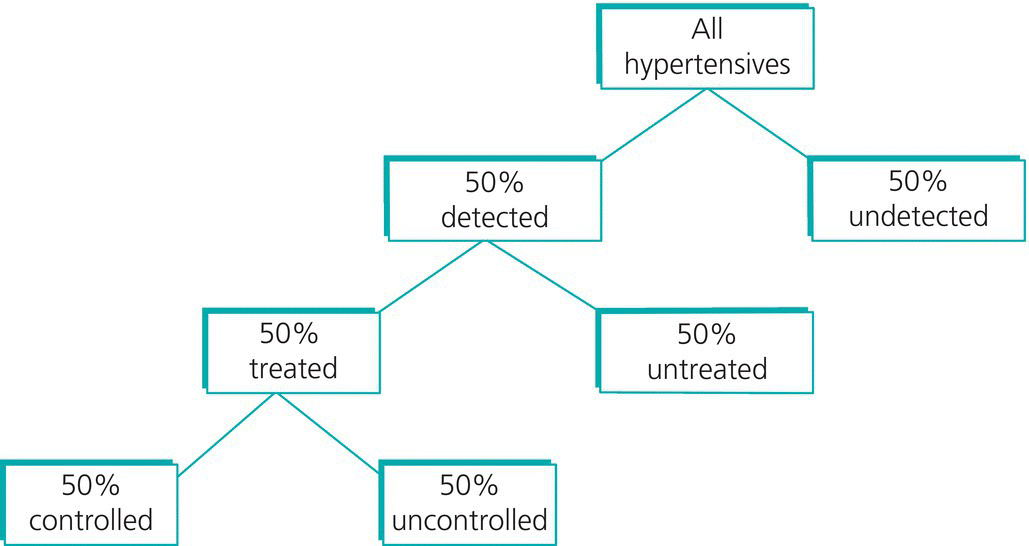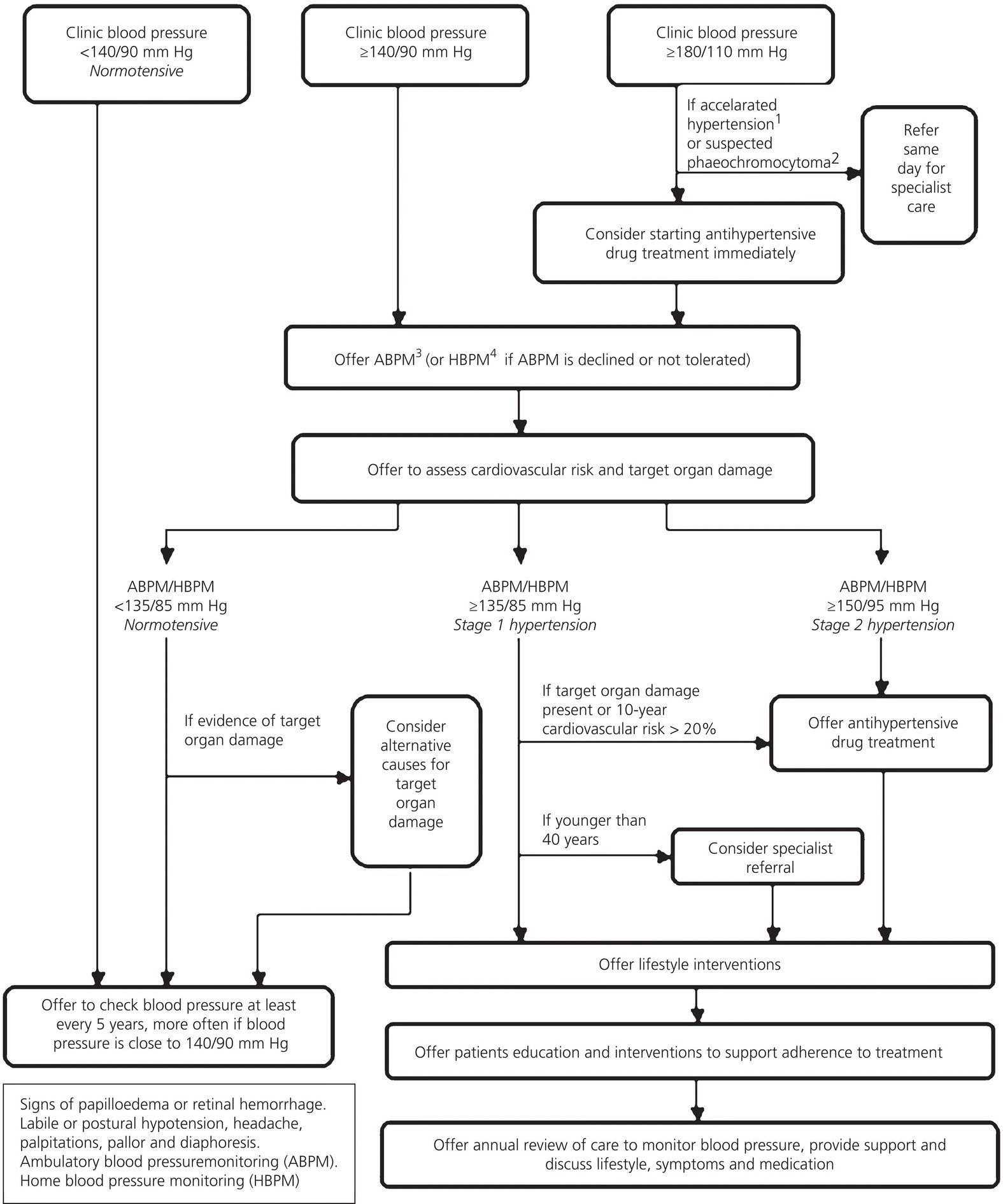Chapter 5 Hypertension is usually a symptomless condition, so, unless special efforts are made, it goes undetected. It is sometimes described as ‘the silent killer’. The state of awareness of hypertension in the general population was said to follow the ‘rule of halves’ so that only a small minority of patients was receiving adequate care (Figure 5.1). Figure 5.1 The ‘rule of halves’; the frequency of undetected, untreated and uncontrolled hypertension in the days before systematic screening programmes in primary care. Only about 12.5% of hypertensive patients were receiving adequate care. Source: Data from Hart, J.T. (1992) British Journal of General Practice, 42, 116–119 It is now generally agreed that the detection and management of hypertension is primarily the responsibility of the primary health-care team based on general practice (known in some countries as family medicine). All countries have different ways of delivering good primary care. In this chapter, we concentrate on the system developed in the United Kingdom. However, the principals of health-care delivery are universal and the UK system is one of many. Of the 25 wealthiest nations, all but one (the United States) have some form of universal health-care coverage, which incorporates the management of common chronic diseases like hypertension. In the screening survey of the town of Renfrew, Scotland, 37.7% of 45- to 64-year-old men and women were found to have a diastolic blood pressure of 90 mm Hg or more at first screening. In many cases, these pressures settled at second screening but the act of rescreening can be regarded as an act of clinical management. Most of the hypertensives detected had mild hypertension (Table 5.1). The 1215 hypertensives of the town were attached to the lists of nine general practitioners. Table 5.1 The prevalence of mild, moderate and severe hypertension in Renfrew In the last decade, guidelines for the detection and management of hypertension have been published in the United Kingdom, Europe and the United States. Differences between these guidelines are minor and there is general agreement on who and how to treat. The remainder of this chapter concentrates on the British guidelines produced jointly by the British Hypertension Society and the National Institute of Health and Care Excellence (BHS/NICE). All guidelines on hypertension management advocate the importance of patient involvement in the successful management and control of hypertension. This includes non-pharmacological or lifestyle changes, as well as patient involvement when considering drug treatment, including education about the drugs patients should take and the drugs’ proven benefits and possible side effects. Patients also need to be warned that, on average, 75% of patients with hypertension need two or more drugs and that one-third will need three or more drugs to achieve good control of blood pressure. The number of drugs needed may be even higher in patients with diabetes, in view of the lower thresholds for treatment in this group (Table 5.2). Table 5.2 Formulation of an individual patient management plan Whilst clinicians should do all they can to minimise the number of tablets to be swallowed every day for years to come, the treatment of comorbidities may need the use of antidiabetic drugs, statins and aspirin. Many patients are generally keen to help with the management of their hypertension with home recording of blood pressure. Many high street chemists now sell inexpensive semi-automatic devices for the measurement of blood pressure, but as many of these have not been validated for accuracy, it is important to check this when purchasing a devise. Blood pressures measured at home (HBPM) probably resemble ambulatory blood pressures measured automatically (ABPM) over 24 h more closely than conventional pressures measured in the clinic, and they provide a more reliable index of cardiovascular risk than casual clinical or office readings (CBPM). Indeed, HBPM features highly in the 2011 BHS/NICE guidelines on hypertension. Patients should be encouraged to buy their own blood pressure machines. For more information, see Chapter 4, Part IV. The Blood Pressure Association in the United Kingdom (now renamed Blood Pressure UK) was set up specifically to provide information and support to people with high blood pressure. Cards that record blood pressure that are held by patients can improve compliance with treatment, particularly if the patient is attending a secondary referral clinic. The national service framework provides health-care service standards in relation to various diseases and patient groups, such as coronary artery disease, elderly people and patients with diabetes. These frameworks have led to targets of achievement that have broadly led to improvements in care. The 2011 BHS/NICE guidance provides a simple algorithm for the follow-up and management of hypertension in primary care (Figure 5.2). Figure 5.2 BHS/NICE recommendations for the management of hypertension in primary care. From National Institute of Health and Clinical Excellence. Hypertension; clinical management of primary hypertension in adults. Source: NICE clinical guideline 127, 2011. Krause, T., et al. (2011) British Medical Journal, 343, d489. Reproduced with permission from BMJ Publishing Group Ltd.
Screening and management in primary care
Detection in general practice

The size of the problem
3060 randomly selected 45–64-year-old man and women
Normotensive (DBP ≤ 89)
1846 (60.3%)
Mild hypertensive (DBP 90–109)
1069 (34.9%)
Moderate hypertensive (DBP 110–129)
130 (4.2%)
Severe hypertensive (DBP ≥ 130)
16 (0.5%)
Patient involvement
Health-care systems
National service frameworks

Screening and management in primary care
Source: Data from Hawthorne, V.M., et al. (1974) British Medical Journal, 3, 600–603.
Only gold members can continue reading. Log In or Register to continue

Full access? Get Clinical Tree


